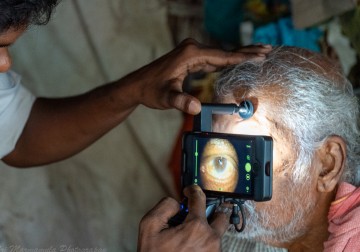Debananda Padhy, Giridhar Pyda, and Dr Rohit Khanna from LVPEI investigate barriers to referrals from primary to secondary eye care services in rural Telangana, India.
Over a billion people have never visited an eye care facility for an eye exam, according to global data on vision loss. Many of these people have limited access to eye care facilities, especially for common causes of vision loss such as uncorrected refractive errors. In a world saturated with smartphones, many more millions struggle with presbyopia, or the inability to see near things with acuity. Together, refractive errors and presbyopia are the main causes of vision impairment in the world. The solution, a simple pair of reading glasses, can be had from any primary care eye centre. Indeed, the pyramidal model pioneered by LVPEI has permanent centres of primary eye care, vision centres, as the first point of access for people.
Despite the presence of vision centres, studies at LVPEI—and across the world—show that presence of eye care facilities alone is insufficient to address the prevalence of vision loss in a population. Human behavior is complex, and a multitude of factors influence healthcare uptake decisions. A study in Andhra Pradesh found patient attitudes (underestimation of sight loss), lack of support, and even cultural barriers. Even those who make it to the primary care centre may drop-off when referred to the next level of care; that is, not all who are referred for care take it up. A funnel is formed, then, with each level of care seeing fewer patients than the level below.
In a new study published in PLOS One, Debananda Padhy, Giridhar Pyda, and Dr Rohit Khanna ask that second-order question: despite visiting a (primary) eye care centre, why do people still drop off? The study surveyed 1507 patients (78%, and about 47.5% female) from a total of 1930 eligible patients who were referred to a secondary care centre from 10 vision centres in rural Telangana. The survey covered patients who visited the vision centres over 6 months in 2019 and 6 months in 2020—covering both before and onset of the COVID-19 pandemic. These patients were surveyed over two years (2021-23) and only adults (18 years old and older) and those living within 50 kilometers from the vision centres were included. Those who visited the nearest secondary centre within 1 year of referral were considered compliant.
Nearly 38% of the participants were non-compliant: they did not visit the secondary centre for follow-up care. About half (52%) of them were either satisfied with care provided at the primary level or were ‘too busy’ to seek further care--their health-seeking need was sated by the vision centre visit, though they still needed care. Another 11% reported that they could not afford treatment costs. Of those surveyed, unmarried individuals—women more than men—and those who lacked formal education were more likely to exhibit poorer compliance to follow-up care. What can be done to improve uptake? The study found that a telemedicine consultation significantly improved compliance. Similarly, the availability of organized transportation to the secondary facility improved the likelihood of compliance. These insights give a deeper insight into the complex choices that support or negate healthcare compliance in rural India.
'Drop-offs from referral chains are an under-studied aspect of eye care service delivery. This study offers a rare insight into the size of the drop-off percentage, and allows us to consider alternative care delivery mechanisms to improve uptake,' says Dr Rohit Khanna, corresponding author of the paper, and the Network Director of Public Health at LVPEI.
Citation
Padhy D, Pyda G, Khanna RC. Barriers to referral uptake from primary to secondary eye care in the L V Prasad Eye Institute Network in South India. PLoS One. 2025 Jun 26;20(6):e0325974. doi: 10.1371/journal.pone.0325974. PMID: 40569932; PMCID: PMC12200678.
Photo credit: Srinivas Marmamula



